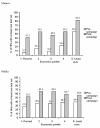Ownership and usage of insecticide-treated bed nets after free distribution via a voucher system in two provinces of Mozambique
- PMID: 20684764
- PMCID: PMC2925365
- DOI: 10.1186/1475-2875-9-222
Ownership and usage of insecticide-treated bed nets after free distribution via a voucher system in two provinces of Mozambique
Abstract
Background: Insecticide-treated bed nets (ITNs) are an efficacious intervention for malaria prevention. During a national immunization campaign in Mozambique, vouchers, which were to be redeemed at a later date for free ITNs, were distributed in Manica and Sofala provinces. A survey to evaluate ITN ownership and usage post-campaign was conducted.
Methods: Four districts in each province and four enumeration areas (EAs) in each district were selected using probability proportional to size. Within each EA, 32 households (HHs) were selected using a simple random sample. Interviews to assess ownership and usage were conducted in each of the selected HHs using personal digital assistants.
Results: Valid interviews were completed for 947 (92.5%) (440 in Manica and 507 in Sofala) of the 1,024 selected HHs. Among participating HHs, 65.0% in Manica and 63.1% in Sofala reported that at least one child under five years of age slept in the house the previous night. HH ownership of at least one bed net of any kind was 20.6% (95% confidence interval [CI]: 7.9%-43.6%) and 35.6% (95% CI: 27.8%-44.3%) pre-campaign; and 55.1% (95% CI: 43.6%-66.1%) and 59.6 (95% CI: 42.4%-74.7%) post-campaign in Manica and Sofala, respectively. Post-campaign HH ownership of at least one ITN was 50.2% (95% CI: 41.8%-58.5%) for both provinces combined. In addition, 60.3% (95% CI: 50.6%-69.2%) of children under five years of age slept under an ITN the previous night.
Conclusions: This ITN distribution increased bed net ownership and usage rates. Integration of ITN distribution with immunization campaigns presents an opportunity for reaching malaria control targets and should continue to be considered.
Figures
Similar articles
-
Bed net ownership in Kenya: the impact of 3.4 million free bed nets.Malar J. 2010 Jun 24;9:183. doi: 10.1186/1475-2875-9-183. Malar J. 2010. PMID: 20576145 Free PMC article.
-
Success of Senegal's first nationwide distribution of long-lasting insecticide-treated nets to children under five - contribution toward universal coverage.Malar J. 2011 Apr 13;10:86. doi: 10.1186/1475-2875-10-86. Malar J. 2011. PMID: 21489278 Free PMC article.
-
Insecticide-treated net ownership and usage in Niger after a nationwide integrated campaign.Trop Med Int Health. 2008 Jun;13(6):827-34. doi: 10.1111/j.1365-3156.2008.02070.x. Epub 2008 Mar 27. Trop Med Int Health. 2008. PMID: 18384476
-
Factors associated with ownership and utilization of insecticide treated nets among children under five years in sub-Saharan Africa.BMC Public Health. 2022 May 10;22(1):940. doi: 10.1186/s12889-022-13347-x. BMC Public Health. 2022. PMID: 35538524 Free PMC article. Review.
-
Ownership and use of insecticide-treated nets during pregnancy in sub-Saharan Africa: a review.Malar J. 2013 Aug 1;12:268. doi: 10.1186/1475-2875-12-268. Malar J. 2013. PMID: 23914731 Free PMC article. Review.
Cited by
-
Assuring access to topical mosquito repellents within an intensive distribution scheme: a case study in a remote province of Cambodia.Malar J. 2015 Nov 24;14:468. doi: 10.1186/s12936-015-0960-4. Malar J. 2015. PMID: 26597653 Free PMC article. Clinical Trial.
-
Community Perceptions and Practices about Malaria Prevention and Control in Iran.Iran J Public Health. 2014 Jan;43(1):62-9. Iran J Public Health. 2014. PMID: 26060681 Free PMC article.
-
Evaluation of community-based continuous distribution of long-lasting insecticide-treated nets in Toamasina II District, Madagascar.Malar J. 2017 Aug 10;16(1):327. doi: 10.1186/s12936-017-1985-7. Malar J. 2017. PMID: 28797252 Free PMC article.
-
Factors associated with use of insecticide-treated net for malaria prevention in Manica District, Mozambique: a community-based cross-sectional survey.Malar J. 2021 Apr 27;20(1):200. doi: 10.1186/s12936-021-03738-7. Malar J. 2021. PMID: 33906642 Free PMC article.
-
Factors influencing consistent use of bed nets for the control of malaria among children under 5 years in Soroti District, North Eastern Uganda.Malar J. 2022 Dec 2;21(1):363. doi: 10.1186/s12936-022-04396-z. Malar J. 2022. PMID: 36461059 Free PMC article.
References
-
- Phillips-Howard PA, Nahlen BL, Kolczak MS, Hightower AW, ter Kuile FO, Alaii JA, Gimnig JE, Arudo J, Vulule JM, Odhacha A, Kachur SP, Schoute E, Rosen DH, Sexton JD, Oloo AJ, Hawley WA. Efficacy of permethrin-treated bed nets in the prevention of mortality in young children in an area of high perennial malaria transmission in western Kenya. Am J Trop Med Hyg. 2003;68:23–29. - PubMed
-
- Lengeler C. Insecticide-treated bed nets and curtains for preventing malaria. Cochrane Database Syst Rev. 2004. p. CD000363. - PubMed
-
- Grabowsky M, Farrell N, Hawley W, Chimumbwa J, Hoyer S, Wolkon A, Selanikio J. Integrating insecticide-treated bednets into a measles vaccination campaign achieves high, rapid and equitable coverage with direct and voucher-based methods. Trop Med Int Health. 2005;10:1151–1160. doi: 10.1111/j.1365-3156.2005.01502.x. - DOI - PubMed
Publication types
MeSH terms
Substances
LinkOut - more resources
Full Text Sources


